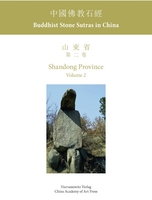|
|
more titles of the subject:
Download:
The second volume on Buddhist stone sutras in Shandong presents the extant inscriptions on the four mountains around the city of Zoucheng: Mount Yi (564 and before 572), Mount Tie (579), Mount Ge (580), and Mount Gang (580). The studies of these inscriptions began in the late 18th century. The history of this scholarly enterprise is discussed in the introductory essay by Lothar Ledderose, “Epigraphers in Zoucheng”.
The inscription of 564 with key passage from the Sutra on the Great Perfection of Wisdom Spoken by Mañjusri on the peak of Mount Yi was only discovered in the 1990s, and its colophon in 2002. A colophon to the same passage engraved further down the mountain names Hulü Wudu of the Northern Qi, probably a Xianbei, who was executed in 572. On Mount Tie a passage from the Great Collection Sutra is carved in the shape of a stele, more than 50 meters high. Its colophon, entitled Stone Hymn, is with a height of 17 meters the largest in China. It is also remarkable for its discussion of the aesthetics of calligraphy. Engraved on Mount Ge is a passage from the Vimalakirti Sutra. The inscriptions on Mount Gang are unique in being distributed over more than thirty cliffs and boulders. The passage describes the enchanting scenery on Mount Malaya, where the Buddha preached the Lankavatara Sutra to a great assembly. Pilgrims read the full text, as they climb the mountain. All texts are fully documented in photographs and rubbings; they are transcribed and translated into English. The volume is in Chinese and English The research team, led by Lothar Ledderose, includes a group at the Heidelberger Akademie der Wissenschaften, and specialists from China, Japan, Europe, and America. |






